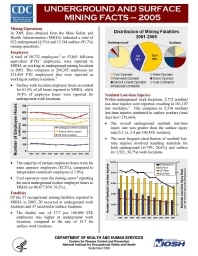Mining Publication: Underground and Surface Mining Facts - 2005
Original creation date: September 2008
Authors: National Institute for Occupational Safety and Health
NIOSHTIC2 Number: 20034781
Pittsburgh, PA: U.S. Department of Health and Human Services, Public Health Service, Centers for Disease Control and Prevention, National Institute for Occupational Safety and Health, DHHS (NIOSH) Publication 2008-157, 2008 Sep; :1-2
Mining Operations: In 2005, data obtained from the Mine Safety and Health Administration (MSHA) indicated a total of 922 underground (6.3%) and 13,744 surface (93.7%) mining operations. Employees: A total of 50,732 employees, or 53,041 full-time equivalent (FTE) employees, were reported to MSHA as working at underground mining locations in 2005. This compares to 260,395 employees (or 235,564 FTE employees) that were reported as working at surface locations. Surface work location employee hours accounted for 81.6% of all hours reported to MSHA, while 18.4% of employee hours were reported for underground work locations. The majority of surface employee hours were for mine operator employees (82.2%), compared to independent contractor employees (17.8%). Coal operators were the mining sector reporting the most underground worker employee hours to MSHA (n=80,877,874; 76.2%). Fatalities: Of the 57 occupational mining fatalities reported to MSHA in 2005, 20 occurred at underground work locations and 37 occurred at surface locations. The fatality rate of 37.7 per 100,000 FTE employees was higher at underground work locations, compared to the rate of 15.7 for surface work locations. Nonfatal Lost-time Injuries: Within underground work locations, 2,772 nonfatal lost-time injuries were reported, resulting in 181,107 lost workdays. This compares to 5,538 nonfatal lost-time injuries attributed to surface workers (total days lost=278,664). The overall underground nonfatal lost-time injury rate was greater than the surface injury rate (5.2 vs. 2.4 per 100 FTE workers). The most frequent classification of nonfatal lost-time injuries involved handling materials for both underground (n=793; 28.6%) and surface (n=1,921; 34.7%) work locations.

NIOSHTIC2 Number: 20034781
Pittsburgh, PA: U.S. Department of Health and Human Services, Public Health Service, Centers for Disease Control and Prevention, National Institute for Occupational Safety and Health, DHHS (NIOSH) Publication 2008-157, 2008 Sep; :1-2
- Coal and metal/nonmetal mining facts - 2008
- Coal and Metal/Nonmetal Mining Facts - 2008 (HTML)
- Coal Contractor Mining Facts - 2001
- Coal Contractor Mining Facts - 2002
- Coal Contractor Mining Facts - 2003
- Coal Contractor Mining Facts - 2004
- Coal Contractor Mining Facts - 2005
- Coal Contractor Mining Facts - 2006
- Mining Fact Sheets
- Rib Falls: A Major Ground Control Issue